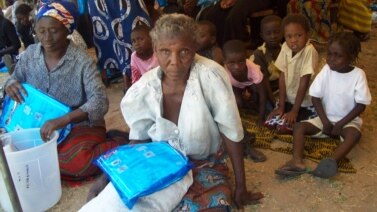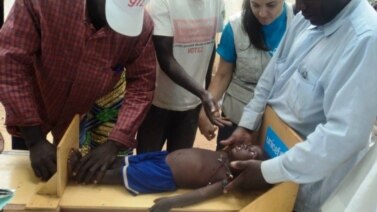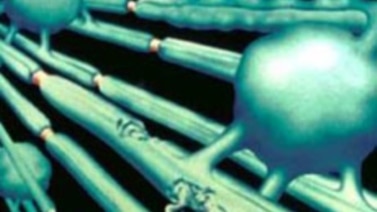
From VOA Learning English, this is Science in the News. I’m Mario Ritter.
And I’m Christopher Cruise. Today we tell about a warning from tropical disease experts. They are seeing an increase in infections from one kind of malaria parasite. We also tell about plans for human testing of a gene therapy for heart disease. Then we report on efforts in Liberia to control sales of medicines. And we tell how Australian scientists are working to help save koalas from disease.
Between 300 million and 500 million cases of malaria are reported worldwide each year. Plasmodium falciparum, a deadly parasite, is responsible for most of the cases. But experts say a lesser known form of the disease could become a more serious threat. They are seeing an increase in infections from the vivax malaria parasite.
An estimated 2.5 billion people live in areas where Plasmodium vivax is common. It is one of five kinds of malaria carried by mosquitoes. The vivax parasite infected 20 million people in 2010. Its signs are less severe than the more common falciparum malaria, which kills about 660,000 people each year.
Peter Zimmerman is a malaria expert with Case-Western Reserve University in Ohio. He says people who become infected with vivax usually feel like they are suffering from a really bad case of influenza.
“It’s highly associated with pretty severe anemia and all the sort, you know, of ‘I don’t feel good’ symptoms that, that go along with it: headache, nausea, being tired, you know, having no energy.”
Yet, he says, malaria can be deadly in someone who is half-starved or suffering from more than one infection. The organism can also hide in the liver and return many times, causing the disease to reappear.
Until now, experts believed 95 percent of the at-risk population in some areas was protected from vivax infection. This is because they lack a certain kind of protein in their red blood cells called a “Duffy” protein. Without it, vivax parasites cannot enter the blood cells.
But Peter Zimmerman and other researchers have found that in Madagascar, people without the Duffy protein may be carrying the vivax parasite.
He says it appears the parasite may be changing so it can overcome natural resistance and infect blood cells that lack the Duffy protein. If so, that could mean that vivax is becoming a bigger threat. But he notes research shows that Duffy negative people are still at a lower risk for vivax malaria. Peter Zimmerman presented his results at a meeting of the American Society of Tropical Medicine and Hygiene in Washington.
Two reports on changes in the infectiousness of Plasmodium vivax were published in the journal PLoS Neglected Tropical Diseases.
New Discovery May Help Fight Heart Disease

Researchers are ready to begin human testing of a new gene therapy to treat a major cause of heart disease. The therapy shrinks enlarged hearts. It helps to improve blood flow and the way the heart operates.
Heart failure is a leading cause of sickness and death around the world. The heart becomes weaker and gets bigger as it works harder to pump enough blood to the rest of the body. A heart attack, untreated high blood pressure or blocked arteries can lead to heart failure. Once the condition develops, the victim usually dies within five years.
People who suffer heart failure lack a fully operational gene called SUMO-1. It helps control calcium that goes in and out of cells in the ventricles, which pump blood to the body.
Roger Hajjar is a cardiologist with Mount Sinai School of Medicine in New York. He led experiments on pigs with heart failure. He found that just a single injection of the gene SUMO-1 improved the operation of the animals’ hearts.
“Regardless of the cause that induced the heart to, to be big, we were able to reverse that.”
His research team discovered another gene, called SERCA2. This gene also controls the movement of calcium in heart cells. Their human tests of replacement gene therapy with SERCA2 are showing similar results to the SUMO-1 experiments in animals.
Doctor Hajjar believes that injecting both genes at the same time into cardiac failure patients might help even more.
“Since we’ve had the experience with SERCA2, we know pretty much the path towards clinical trials from, from discovery to, to the bedside. And, we feel that within a couple of years, we should be able to take this, this program forward, for, in terms of gene therapy in patients.”
The treatment involving SUMO-1 and SERCA2 uses a harmless cold virus to carry the genes into the heart.
Liberian Officials Concerned by Fake Medicines
Liberia is taking steps against the sellers of fake -- copied -- or out-of-date medicines. But the government efforts have met resistance from some Liberians, especially in rural communities. They say they only have enough money to pay for old or fake medicines. The traffic and sale of such drugs is widespread in West Africa. But this industry has created serious risks to public health.
It is not hard to find traveling drug salesmen in Liberia. They are known locally as “black bag doctors.”
John Harris was walking along a road just a few kilometers outside the capital, Monrovia. That is where a VOA reporter met him.
John Harris wore a backpack and carried a bucket. Both were full of unmarked plastic bags of pills. He said they were painkillers and anti-malaria drugs.
John Harris said this is not the kind of life he expected when he finished medical school.
“How does the government expect us to survive when there is no job? So I do this, moving from villages and towns, and sell these drugs to the people. At least we are helping government. Some of the places we go, there are no health facilities. So I think we are a help.”
But it is a crime to sell medicines in the streets without official permission. Inspectors from Liberia's Pharmaceutical Board have been searching for drug salesmen like John Harris.
Chief Pharmacist Reverend Tijli Tarty Tyee says the medicines and treatments from black bag sellers are not effective. He says they are either old, damaged by sun or moisture, or just fake. He says such medicines cannot cure sicknesses.
“… people taking the medicines, there is a potential of having what we call microbial resistance to the medicines. And when we have resistance to our important medication, then we are in a very serious, serious situation.”
Tijli Tarty Tyee says he understands that people need medicines -- and the costs have to be kept low. “They want to have a shortcut in getting medicines, but that shortcut is dangerous to them,” he says.
In addition to the resistance of local communities, the sellers themselves have also resisted. The Liberian official says inspectors have been injured on the job.
The United Nations’ Office on Drugs and Crime says fake medicines in West Africa are both imported and manufactured locally. And government supervision of the medicines is limited.
Flour has been identified as the antibiotic amoxicillin. Manufacturers try to increase profits by reducing the amount of an active ingredient. Or real medicines can make their way into a street seller’s backpack after they are too old to help cure disease or control pain.
Experts say the true depth of the problem is nearly impossible to measure in West Africa. The UN’s Office on Drugs and Crime says even doctors and pharmacists cannot be totally sure what they are administering to patients is real.
Finally, Australian scientists are climbing trees to study healthy koalas in a colony. Researchers at the University of Queensland are going to great heights to document the lives and behaviors of the animals. The goal is to help save other koalas threatened by disease.
A koala is sometimes called a “bear” because it looks similar to that animal. But the koala is different, and native to Australia.
Although the animals are called “bears,” they are really marsupials, related to kangaroos and opossums. They survive by eating leaves from eucalyptus trees.
The researchers say koalas in parts of the country are suffering from chlamydia. The disease causes blindness and inability for the females to reproduce. Experts believe genetics could be partly to blame for the sickness.
Healthy animals in northeastern Australia are captured and tested to help the research team learn why they do NOT have the disease. Researchers are especially interested in joeys, the baby koalas. After the female koala gives birth, she carries her joey in her pouch for six months.
In addition to chlamydia, other threats to koalas include water pollution, loss of homeland and road accidents.
The study of koalas will continue for years across 63,000 hectares in Australia.
This Science in the News written by Milagros Ardin and Jerilyn Watson. Our producer was June Simms. I’m Christopher Cruise.
And I’m Bob Doughty. To learn more about our programs, go to our website: learningenglish.voanews.com. Join us again next week at this time for more news about science on the Voice of America.




